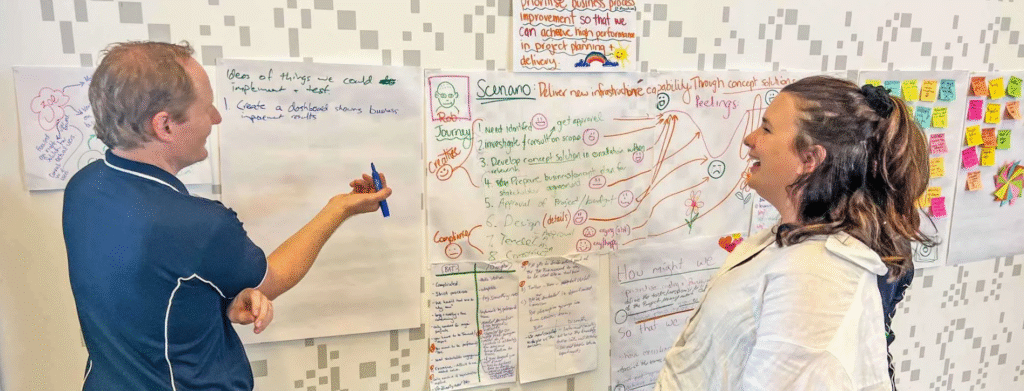In today’s dynamic business world, teams must find creative, empathetic ways to solve complex problems. A Design Thinking Workshop does exactly that—helping teams work together, uncover fresh perspectives, and solve real challenges with confidence.
What Is a Design Thinking Workshop?
A Design Thinking Workshop is a guided, immersive experience that takes teams through a human‑centered problem‑solving method. It encourages participants to start with empathy, understand real human needs, then ideate, prototype, and test solutions rapidly. Rather than relying solely on traditional analysis, this workshop empowers creativity, collaboration, and action.
Why This Workshop Works
Empathy Sparks Solutions
The workshop begins by deeply understanding the people involved—through storytelling, observation, or simple interviews—building empathy and uncovering real needs and pain points.
Clarity Through Definition
Instead of jumping straight to solutions, teams first define and frame the actual problem clearly. This helps focus energy on solving the right problem rather than just any problem.
Ideation Unleashes Creativity
Encouraged to think freely and divergently, participants generate many ideas—no matter how unconventional. This helps unlock bold, original responses to complex issues.
Prototypes Encourage Learning
Simple prototypes—sketches, mockups, or role‑plays—bring ideas to life quickly and affordably. This hands‑on approach helps teams visualize solutions and learn fast.
Testing Builds Confidence
By getting early feedback from users or stakeholders, teams refine their ideas and adapt based on real insight—boosting confidence that their solutions will work.
How a Design Thinking Workshop Transforms Teams
Breaks Down Silos
Bringing together people from different roles—design, strategy, operations—turns the workshop into a collaborative melting pot. Diverse voices help teams discover perspectives they’d otherwise miss.
Cultivates a Creative Mindset
More than problem‑solving, the workshop helps people shift from fixed thinking to an exploratory mindset. Teams become comfortable with experimentation—and open to learning from failure.
Produces Actionable Outcomes
These workshops don’t just spark ideas—they deliver tangible outcomes like refined prototypes or clear next‑steps that teams can act on immediately.
Scalable and Repeatable
Once teams experience this method, they can apply it in varied contexts—new product development, process re‑engineering, or service innovation—using the same structured, creative process again and again.
Who Benefits Most
These workshops are ideal for anyone—even those without a design background. Whether you’re in leadership, product, HR, marketing, or strategy, the process offers practical tools and new ways of thinking. It’s especially valuable for teams tackling ambiguous, customer‑focused challenges and those eager to innovate from within.
Choosing Between Virtual or In‑Person Formats
Virtual workshops offer flexibility and work well for distributed teams. They often include digital versions of collaborative tools that facilitate empathy, prototyping, and testing—even across distances.
In‑person workshops bring energy, spontaneity, and stronger team bonding. Physical tools like post‑its, prototypes, and shared whiteboards can help. Many facilitators offer hybrid or blended options to fit unique team needs.
Lasting Benefits Beyond the Workshop
Attending a Design Thinking Workshop does more than solve one challenge—it seeds a new way of thinking. Teams leave with:
- A repeatable framework for solving future problems
- Increased creative confidence and willingness to experiment
- Better collaboration habits and cross‑functional empathy
- Fresh energy and momentum for tackling bigger challenges ahead
When participants can prototype, test, and iterate rapidly, they accelerate innovation—and help reshape team culture toward curiosity and user‑centered design.
Conclusion
A Design Thinking Workshop is a powerful tool to ignite creative problem‑solving, deepen collaboration, and design solutions that truly resonate. By combining empathy with structured experimentation, it equips teams to innovate confidently. For this kind of transformative experience, consider working with someone who knows how to bring ideas to life. The conclusion is brought to you by Simon Banks.







